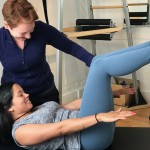August 29, 2018
You Should Thank your Clients for Asking This Motivating Question
by Holly Furgason
I want to share with you the most important question my clients ask me. It’s a question that I’ve spent my career trying to answer. It’s a question that motivates me to improve my communication and teaching skills. The question is, “Why?”
Remember being a little kid? Exploring the world by asking your parents, “Why?” Many times each day asking, “Why, Mom?” or “Why, Dad?”
As we get older, we learn that asking “why?” in every situation may not be socially acceptable. So, we keep silent and ask the question in our heads. But as far as I can tell, we still desperately want to know the answer to “why?”. Especially in unfamiliar situations like learning how to move our bodies, improve our posture, or build strength in ways that are difficult to feel.
Both as teachers and students, it’s critical to stay curious. Asking “why?” shows curiosity.
Thinking back on when I first started teaching, most of my challenges revolved around the fact that I couldn’t answer many of those client “why” questions. I was terrified someone would ask a question I couldn’t answer. “Why are we doing this exercise?” was a common question. I would answer as best I could. But often their questions would haunt me because I really wanted to feel like I fully answered.
Truthfully, I would occasionally get frustrated with the question even though, and largely because, I knew it was knowledge I was lacking.
Now, I feel that some of the best clients to teach are the ones that are not afraid to ask “why?” when they don’t understand. These clients express a true desire to understand and analyze the information they’re learning. Perhaps more importantly, it challenges my ability to distill complex concepts into easy-to-understand ideas and pushes me to be a better teacher.
I still geek out about how I’m continuing to learn more every day, pushing towards better answers to these “why” questions.
I consider my Pilates teacher training to be an investigation into “Why?”: why perform this exercise; why choose this exercise for a specific client; why modify for specific postures; why regress or progress an exercise.
These days there are so many Pilates “training” programs available. It’s becoming harder to decipher what’s true to the original method Joseph Pilates created and what is not. Amongst programs, there are a few key differences in their approaches. It was in examining these differences that I found the program that best met my goals and what I was looking to share with my future clients.
Sometimes the differences between various Pilates approaches can be subtle and sometimes they can be huge. Ultimately, I decided to pursue training through STOTT PILATES® because 1) it incorporated current health, fitness, and sport science while respecting the original work of Joseph Pilates; 2) it focused on working with special populations; and 3) it’s an internationally recognized certification.
From my very first teacher training course, the course faculty encouraged me to write down the goal of every exercise, understand the muscles that were targeted, and be able to modify each exercise for different levels or postural types. I was beginning to build the foundation for the “why” answers.
Now, most of my day is spent answering these “why” questions. I believe whether you’re a teacher-in-training or have been teaching for years, it’s the most important question you can answer for your clients. I believe you’ll have the best opportunity for long-term success and employment by learning to look for, and explain, the “why” for every exercise.
Let me see if I can illustrate the nuances using The Hundred exercise.
The Question
“Why are we doing this exercise?”
The Answer
- To build core strength and stability.
- The Hundred works on abdominal strength, rhythm, and coordination.
- We’re targeting the rectus abdominis, internal and external obliques in an isometric contraction to maintain the thoracic flexion against the long levers of the arms and legs.
- The adductors are squeezing the legs together, which should feed up into the pelvic floor and transversus abdominis connection.
- The hip flexors, hip abductors, and quadriceps are working isometrically to hold the legs in the air.
- The strong pumping of the arms works the lats and challenges shoulder stability.
You can modify The Hundred for different levels or postural types by:
Putting the feet flat on the mat and working in neutral pelvis
This might be a good modification for someone with a flat back, posterior pelvic tilt, or weak abdominals such that they cannot work with their legs in the air.
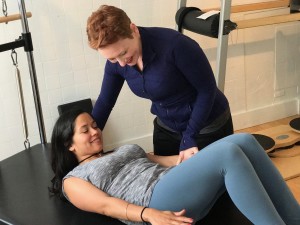
Holding the legs bent in tabletop position
Having the legs in a shorter lever position still challenges the abdominals but doesn’t require as much strength as having the legs fully extended in a long lever.
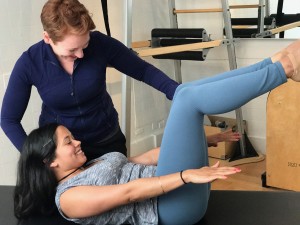
Leaving the head down
Keeping the head down may help lengthen an exaggerated thoracic curve and reduce tension or strain in the neck.
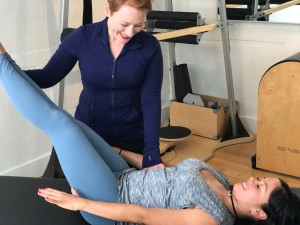
Propping the upper body up with an Arc Barrel
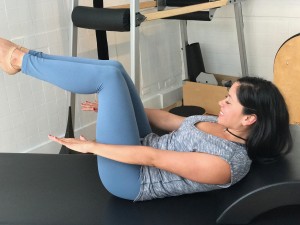
Provides assistance in thoracic flexion which might be good for someone who tends to just flex the head, has flat thoracic, or tenses in the neck.
These are obviously just a few ways to modify.
All the above descriptions you’d want to be able to say in a variety of different ways, so you can communicate with a variety of clients.
In addition to the above, you’d want to be able to offer a customized explanation of how this exercise will help the individual in their daily life.
These “why” answers demonstrate a few small reasons why education is so important. You’re not just talking the client through the exercises, but actually seeing them in the exercises.
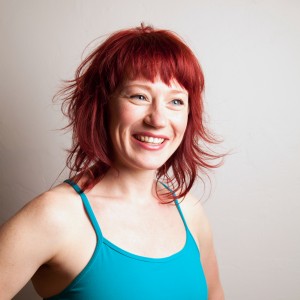 Holly Furgason is the founder and CEO of Blue Sparrow Pilates, which is the STOTT PILATES® Teacher Training center for San Francisco, CA. Holly has been teaching Pilates for more than 17 years, is fully certified and a Lead Instructor Trainer for STOTT PILATES. A University of Michigan dance grad, she went on to earn her MFA from Mills College in Oakland, CA.
Holly Furgason is the founder and CEO of Blue Sparrow Pilates, which is the STOTT PILATES® Teacher Training center for San Francisco, CA. Holly has been teaching Pilates for more than 17 years, is fully certified and a Lead Instructor Trainer for STOTT PILATES. A University of Michigan dance grad, she went on to earn her MFA from Mills College in Oakland, CA.

